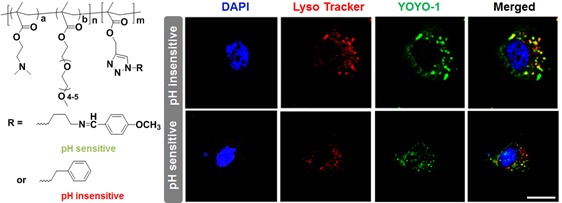Abstract
Cationic polymer gene delivery vehicles that effectively resist premature serum degradation often have difficulty releasing their nucleic acid cargoes. In this work, we report a pH-sensitive polymer (SP), poly(oligo(ethylene glycol) monomethyl ether methacrylate)-co-poly(2-(dimethylamino)ethyl methacrylate)-block– poly(propargyl methacrylate-graft-propyl-(4-methoxy-benzylidene)-amine) (p(PMA-PMBA)–b-(p(OEGMA-DMAEMA)), for successful in vitro and in vivo gene transfer. In the physiological condition, the hydrophobization of p(OEGMA-DMAEMA) polycations by p(PMA-PMBA) significantly enhanced the stability of its polyplexes counterpart. In endosomes, the polymer undergoes an acid-triggered hydrophilic transition through the cleavage of benzoic imines, thus allowing the vector to quickly release nucleic acid cargo due to the loss of hydrophobic functionalization. Compared to a pH-insensitive polymer (IP), SP exhibited more significant luciferase plasmid delivery efficiency with HeLa cells in vitro and with in vivo intraventricular brain injections. Therefore, the polymer designed here is a good solution to address the dilemma of stability and cargo release in gene delivery, and may have broad potential applications in therapeutic agent delivery.


